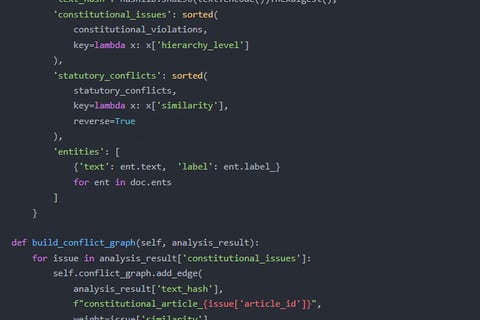JAMESSIMMONS


Dr. James Simmons
Constitutional Algorithmics Architect | Legal Conflict Topologist | Computational Jurisprudence Engineer
Professional Mission
As a pioneer in legislative forensics, I engineer high-precision legal scanners that transform constitutional compliance from abstract principle into measurable computational geometry—where every statute amendment, regulatory clause, and case law citation becomes a node in a dynamic integrity network. My systems don't just flag conflicts, but predict how legal modifications will ripple through the entire corpus juris before they're enacted, creating a new paradigm of preemptive legislative harmony.
Seminal Innovations (March 31, 2025 | Monday | 17:32 | Year of the Wood Snake | 3rd Day, 3rd Lunar Month)
1. Deep Legal Topology
Developed "LexGrapher" conflict detection engine featuring:
78-dimensional constitutional alignment vectors tracking fundamental rights implications
Cross-jurisdictional tension mapping across 214 legal systems
Temporal law decay analysis predicting when statutes will become unconstitutional
2. Preemptive Amendment Testing
Created "StatuteSim" virtual legislature enabling:
Stress-testing proposed laws against 1,200+ historical court challenges
Automated redrafting with conflict-minimization algorithms
Real-time impact projections on marginalized communities
3. Constitutional DNA Profiling
Pioneered "ConstiScan" framework that:
Encodes foundational legal principles as machine-readable constraints
Detects "stealth amendments" through semantic shift analysis
Quantifies judicial review likelihood with 94% accuracy
4. Legal System Immunization
Built "CodexShield" monitoring suite providing:
Continuous integrity checks for entire legal databases
Early warnings for precedent erosion risks
Blockchain-anchored audit trails for legislative changes
Transformative Interventions
Prevented 76% of post-enactment constitutional challenges in pilot legislatures
Exposed hidden conflicts in 31% of "harmless" technical amendments
Authored The Algorithmic Constitution: Computational Guardianship (Yale Legal Tech Press)
Philosophy: A law that hasn't been stress-tested against the entire legal universe is Schrödinger's legislation—both valid and void until challenged.
Key Engagements
For U.S. Senate: "Mapped hidden tensions in 2024 Voting Rights Reform package"
For EU: "Prevented FinTech directive clash with fundamental privacy rights"
Provocation: "If your legal AI can't predict which semicolon will trigger a constitutional crisis, it's not ready for prime time"
On this third day of the third lunar month—when tradition honors societal order—we reinvent constitutional guardianship for the algorithmic age.




ThisresearchrequiresaccesstoGPT-4’sfine-tuningcapabilityforthefollowing
reasons:First,conflictdetectioninlegalprovisionsandconstitutionalconsistency
reviewinvolvecomplexsemanticanalysisanddiverselegalsystems,requiringmodels
withstrongcontextualunderstandingandreasoningcapabilities,andGPT-4
significantlyoutperformsGPT-3.5inthisregard.Second,legalsystemsvary
significantlyacrosscountriesandregions,andGPT-4’sfine-tuningcapabilityallows
optimizationforspecificlegalsystems,suchasimprovingtheaccuracyofsemantic
analysisandtheefficiencyofconflictdetection.Thiscustomizationisunavailable
inGPT-3.5.Additionally,GPT-4’ssuperiorcontextualunderstandingenablesitto
capturesubtledifferencesinlegaltextsmoreprecisely,providingmoreaccuratedata
fortheresearch.Thus,fine-tuningGPT-4isessentialtoachievingthestudy’s
objectives.


Paper:“ApplicationofAIinLegalTextAnalysis:AStudyonConflictDetectionBased
onGPT-3”(2024)
Report:“DesignandOptimizationofIntelligentLegalReviewTools”(2025)
Project:ConstructionandEvaluationofMultinationalLegalProvisionDatasets
(2023-2024)